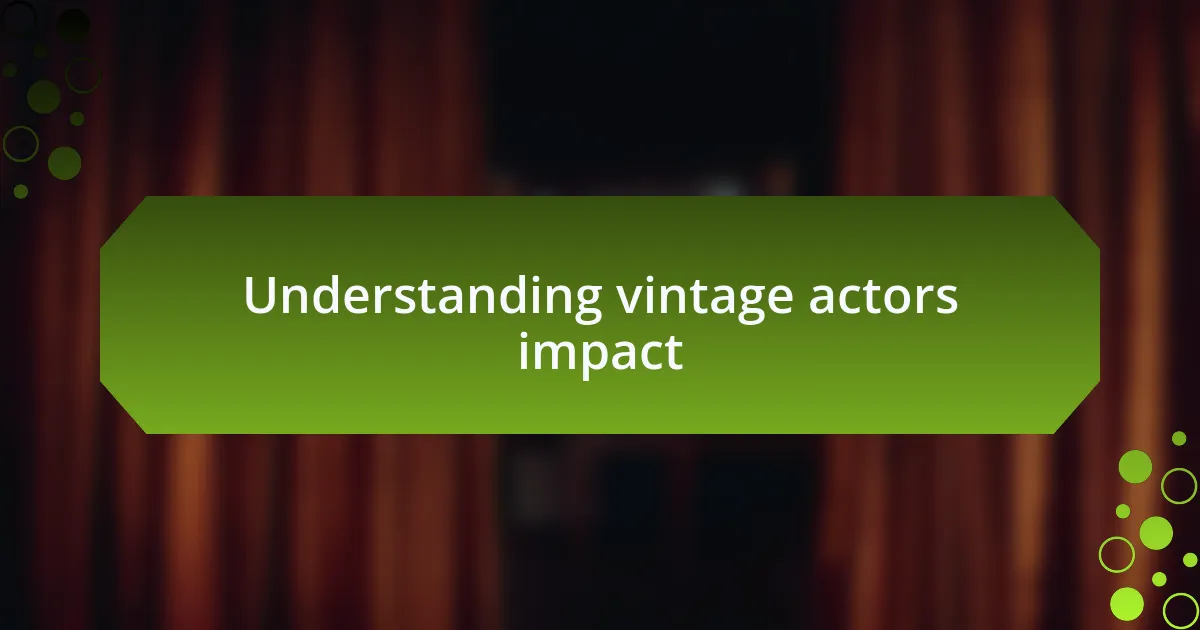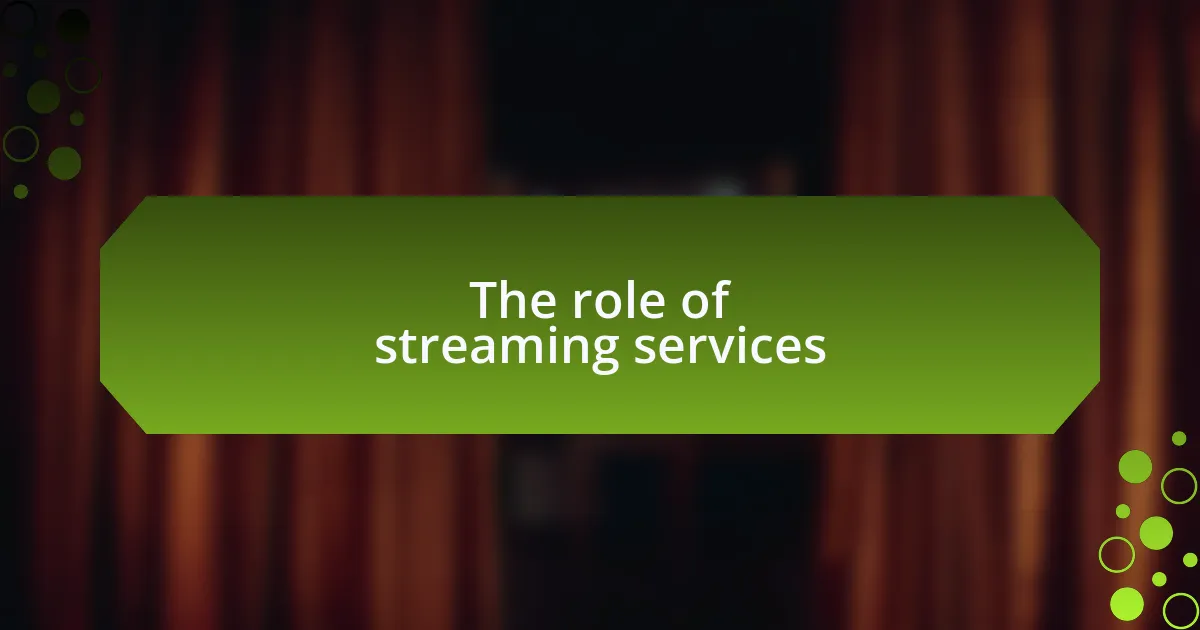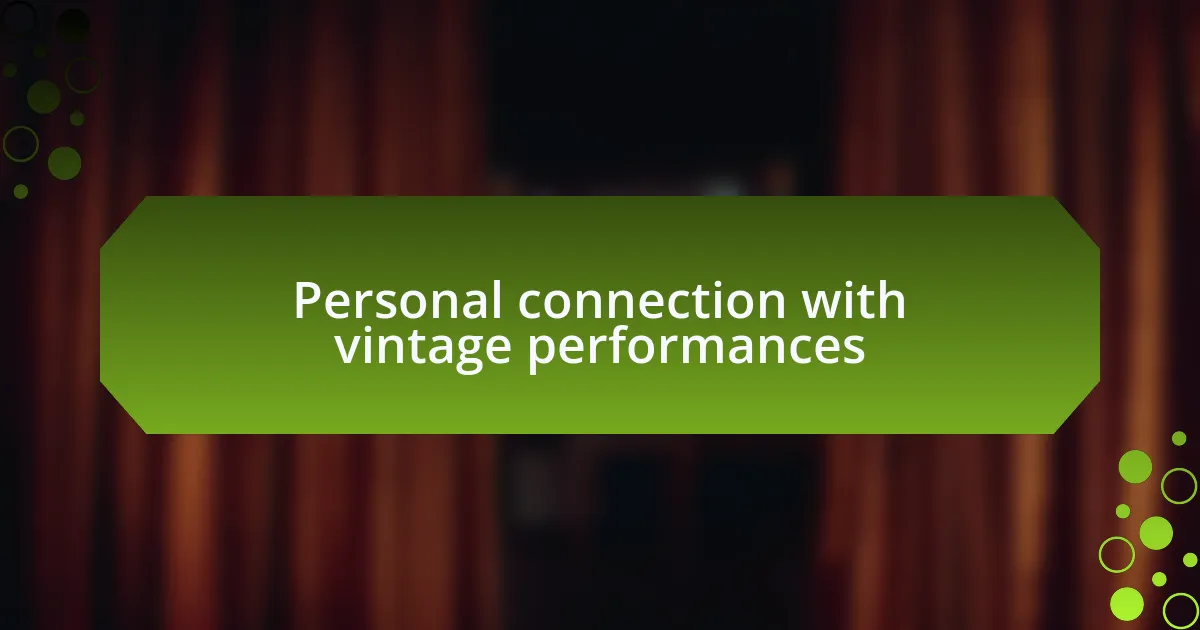Key takeaways:
- Vintage actors like Audrey Hepburn and Humphrey Bogart possess a timeless authenticity and emotional depth that influences modern storytelling.
- Streaming services enable easy access to classic films, allowing viewers to connect with cultural history and explore the artistry of vintage cinema.
- Watching vintage films provides insights into societal changes over time, enhancing the viewing experience as a conversation with history.
- Personal connections with vintage performances evoke nostalgia and reflect universal human experiences, bridging generational gaps in storytelling.

Understanding vintage actors impact
Vintage actors have a unique ability to transport us back to different eras, capturing a rawness in their performances that feels almost timeless. I remember the first time I watched a classic film featuring Audrey Hepburn; her charm and grace left such a profound impression on me that I found myself researching her life and impact on cinema. How did she manage to convey so much emotion with just a flicker of her eyes?
Their performances often carry an authenticity that’s increasingly rare today. For instance, I still recall seeing Humphrey Bogart in “Casablanca”, and it struck me how every line he delivered was dripping with honesty and passion. Can you imagine the influence these actors had on aspiring filmmakers and actors? Their artistry paved the way for modern storytelling, and it’s fascinating to see how their legacies ripple through the industry today.
Each vintage actor has a story that reflects the culture and values of their time. Watching these films, I often ponder how actors like James Dean or Marilyn Monroe addressed societal issues through their characters. Doesn’t it make you wonder what the world would be like if we still embraced that kind of poignant storytelling? Their agency and impact on film and society remain an essential part of our cinematic history, reminding us that emotions captured on screen have the power to resonate for generations.

The role of streaming services
Streaming services have fundamentally transformed how we access classic films featuring vintage actors. For me, there’s something magical about scrolling through an endless catalog of titles from the past. I often find myself rediscovering gems from the golden age of Hollywood that I thought I’d never have the chance to see again. It’s like the thrill of uncovering a hidden treasure, especially when a forgotten performance resonates on a deeper level.
The convenience of streaming allows me to dive into the world of vintage cinema whenever I wish, which feels empowering. I remember a rainy afternoon when I stumbled upon “Roman Holiday,” and it was the perfect escape. Streaming gives us the ability to curate our own viewing experience, letting nostalgia guide our choices. Isn’t it fascinating how technology can connect us with stories and actors from decades ago, creating a bridge between generations?
Streaming platforms not only host these timeless films but also highlight their cultural significance through curated collections or special features. I often find myself fascinated by the documentaries that delve into an actor’s life and how their performances shaped the landscape of entertainment. Have you ever wondered how a single performance can spark a renaissance of appreciation for an entire era of filmmaking? These services help ensure that these iconic figures maintain their rightful place in cinema, elevating our understanding of their artistry.

How vintage films enhance viewing
Vintage films have a unique way of pulling me into their world, making it hard to resist their charm. I remember watching “Casablanca” for the first time and being entranced by the chemistry between Humphrey Bogart and Ingrid Bergman. There’s an authenticity in their performances that feels like a window into past emotions and experiences, something that modern films often struggle to replicate.
The richness of vintage films goes beyond just storylines; it’s about the cinematography and the artistry of a bygone era. Each frame carries a certain visual quality that tells its own story. I often find myself pausing to appreciate the craftsmanship of lighting and set design—details that seem to have a life of their own. Have you ever noticed how the meticulous care in these films evokes a sense of nostalgia, almost like visiting an old friend?
Watching vintage films also provides a perspective on societal norms and cultural shifts over time. When I watch “Breakfast at Tiffany’s,” I can’t help but reflect on how the portrayal of women in film has evolved since then. It’s captivating to explore these shifts and recognize how they mirror changes in our own lives. Such insights transform the viewing experience from mere entertainment to an engaging conversation with history.

Discovering vintage actors online
Uncovering vintage actors online has been a delightful journey for me. I stumbled upon a treasure trove of classic performances while browsing streaming platforms dedicated to vintage cinema. It was like opening a time capsule—every actor, from Cary Grant to Katharine Hepburn, introduced me to a different era of acting that feels both foreign and familiar. Have you ever felt that thrill when you discover a hidden gem from the past?
Social media plays a pivotal role in this exploration. I often find myself joining groups and forums where fellow enthusiasts share insights about iconic performances and lesser-known works. Just the other day, I read a passionate post about the incredible depth of performances by Greta Garbo, which led me to search out her films. It’s amazing how these discussions can spark new interests and drive us to uncover the unique artistry of vintage actors that might otherwise slip under our radar.
In my experience, browsing through online archives and databases makes learning about these actors incredibly engaging. I recall a late-night diving into a documentary about the life of James Dean. The way they dissected his short but impactful career brought so much context to his performances. It reminded me of how understanding an actor’s background can deepen our appreciation for their craft. What new perspectives might you gain by exploring the lives and stories of these wonderful performers?

Personal connection with vintage performances
There’s something profoundly intimate about watching a performance from a bygone era. I often find myself captivated by the way vintage actors convey emotions with such subtlety. For instance, watching Audrey Hepburn in “Breakfast at Tiffany’s” brings me back to my own youthful dreams and longings. Isn’t it remarkable how a single scene can evoke memories and feelings from our own lives?
I remember the first time I saw Marlon Brando in “A Streetcar Named Desire.” His raw intensity struck a chord within me, resonating deeply with the tumultuous emotions I experienced in my own relationships. It’s this connection that makes these performances resonate; they tap into universal human experiences that remain relevant, no matter the time period. Have you ever felt that rare moment where a character’s struggle mirrored your own life?
What truly enchants me about these vintage performances is their ability to transport us across time. I still feel a rush of nostalgia when I think of my grandmother’s stories about watching classic films as a young girl. Her recounting, combined with my own viewing, creates a personal bridge between our experiences. How do these vintage stories connect with your own memories and shape your understanding of the past?
![]()
Exploring iconic vintage film scenes
Exploring iconic vintage film scenes often allows me to witness the art of storytelling at its finest. Take, for instance, the climactic moment in “Casablanca,” where Humphrey Bogart utters, “Here’s looking at you, kid.” This simple line encapsulates the essence of love and sacrifice, making me reflect on my own relationships and the choices I’ve made. Isn’t it captivating how a few words can carry so much weight and emotion?
One scene that has always struck a chord with me is the dramatic dance between Gene Kelly and Debbie Reynolds in “Singin’ in the Rain.” Their joyful exuberance reminds me of the carefree moments I had while dancing with friends in my living room. It’s a testament to how these vintage films capture the pure elation of life, inviting us to not only watch but to feel and remember our own joyful experiences.
I vividly recall the intensity in the final scene of “Gone with the Wind,” where Scarlett O’Hara vows to rebuild her life. This resolve resonates deeply with me, as I’ve faced my moments of adversity and the need to find strength within myself. Why do iconic scenes like this linger in our minds? Perhaps it’s because they reflect the human spirit’s resilience, connecting us through shared struggles and hopes across generations.